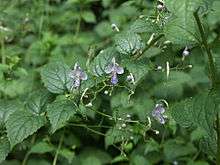Caryopteris
| Bluebeards | |
|---|---|
 | |
| Caryopteris divaricata | |
| Scientific classification | |
| Kingdom: | Plantae |
| (unranked): | Angiosperms |
| (unranked): | Eudicots |
| (unranked): | Asterids |
| Order: | Lamiales |
| Family: | Lamiaceae |
| Genus: | Caryopteris Bunge |
| Synonyms[1] | |
| |
Caryopteris (bluebeard; Chinese: 莸属 you shu) is a genus of flowering plants in the family Lamiaceae (formerly often placed in the family Verbenaceae). They are native to east Asia (China, Korea, Japan, Mongolia).[1][2][3][4][5]
They are herbaceous plants or small shrubs growing to 1–4 m tall. The leaves are opposite, simple ovate to lanceolate, with an entire or crenate margin; they are often aromatic. The blue or white flowers are pollinated by butterflies and bumblebees. The fruit is a four-valved capsule containing four seeds.[3][4][5]
- Species[1]
- Caryopteris forrestii Diels - Guizhou, Sichuan, Tibet, Yunnan
- Caryopteris glutinosa Rehd. - Sichuan
- Caryopteris incana (Thunb. ex Houtt.) Miq. - Taiwan, Korea, Japan, Anhui, Fujian, Guangdong, Guangxi, Hubei, Hunan, Jiangsu, Jiangxi, Zhejiang
- Caryopteris jinshajiangensis Y.K.Yang & X.D.Cong - Yunnan
- Caryopteris mongholica Bunge - Mongolia, Gansu, Hebei, Nei Mongol, Shaanxi, Shanxi
- Caryopteris tangutica Maxim. - Gansu, Hebei, Henan, Hubei, Shaanxi, Sichuan
- Caryopteris trichosphaera W.W.Smith - Tibet, Sichuan, Yunnan
- formerly included
- Caryopteris aureoglandulosa (Vaniot) C. Y. Wu = Schnabelia aureoglandulosa (Vaniot) P.D.Cantino
- Caryopteris bicolor (Roxb. ex Hardw.) Mabb. = Pseudocaryopteris bicolor (Roxb. ex Hardw.) P.D.Cantino
- Caryopteris divaricata Maxim = Tripora divaricata (Maxim.) P.D.Cantino
- Caryopteris nepetifolia (Benth.) Maxim = Schnabelia nepetifolia (Benth.) P.D.Cantino
- Caryopteris paniculata C.B.Clarke = Pseudocaryopteris paniculata (C.B.Clarke) P.D.Cantino
- Caryopteris siccanea W.W.Sm. = Rubiteucris siccanea (W.W.Sm.) P.D.Cantino
- Caryopteris terniflora Maxim. = Schnabelia terniflora (Maxim.) P.D.Cantino
Cultivation and uses
Though several Caryopteris species are grown in botanical gardens, as ornamental plants the species have largely been superseded in gardens by the hybrid Caryopteris × clandonensis (C. incana × C. mongholica). The accidental cross that produced it occurred in the garden of Arthur Simmonds at Clandon, near Guildford, Surrey.[6] In 1930, wishing to propagate C. mongholica, he gathered seeds from a plant that was growing near C. mastacanthus. When the seedlings eventually flowered in their second year, hybrids appeared. The final selection, however, was made of a self-sown volunteer that appeared under C. mastacanthus, and eventually smothered it. It began winning Royal Horticultural Society medals in 1933.[7][8] This small, deciduous, aromatic shrub has grey-green leaves and produces masses of blue flowers in late summer.[9] There are several cultivars with flowers in shades of blue or white, including 'Blue Mist', 'Heavenly Blue', 'Longwood Blue', 'Dark Knight', 'Summer Sorbet' and 'Pershore'.
The cultivars 'Arthur Simmonds',[10] 'First Choice'[11] and 'Worcester Gold'[12] have gained the Royal Horticultural Society's Award of Garden Merit.
Caryopteris × clandonensis, an unusual plant in American gardens in the 1960s,[13] has become more familiar there, especially in xeriscaping.
Like Buddleja, the woody stems can die back in the winter, particularly in colder climates and on heavy soils. They prefer well-drained, sandy soil in full sun, but does not need especially rich soil or constant moisture.
Leaves and herbaceous stems have a terpene aroma like eucalyptus, especially when lightly bruised.
References
- 1 2 3 Kew World Checklist of Selected Plant families
- ↑ Germplasm Resources Information Network: Caryopteris
- 1 2 Flora of China: Caryopteris
- 1 2 Flora of Pakistan: Caryopteris
- 1 2 Huxley, A., ed. (1992). New RHS Dictionary of Gardening. Macmillan ISBN 0-333-47494-5.
- ↑ David S. MacKenzie, Perennial Ground Covers, s.v. "Caryopteris × clandonensis 'Arthur Simmonds'".
- ↑ Coats (1964) 1992.
- ↑ "The genus is usually represented by Caryopteris × clandonensis, which has superseded all the original species". Alice M. Coats, Garden Shrubs and Their Histories (1964) 1992, s.v. "Caryopteris".
- ↑ RHS A-Z encyclopedia of garden plants. United Kingdom: Dorling Kindersley. 2008. p. 1136. ISBN 1405332964.
- ↑ "RHS Plant Selector - Caryopteris × clandonensis 'Arthur Simmonds'". Retrieved 13 June 2013.
- ↑ "RHS Plant Selector - Caryopteris × clandonensis 'First Choice'". Retrieved 13 June 2013.
- ↑ "RHS Plant Selector - Caryopteris × clandonensis 'Worcester Gold'". Retrieved 13 June 2013.
- ↑ Wayside Gardens introduced "blue Mist" in the 1950s: "several years ago" in Popular Gardening and Living Outdoors, 7 (1956:15).
External links
-
 Media related to Caryopteris at Wikimedia Commons
Media related to Caryopteris at Wikimedia Commons -
 Data related to Caryopteris at Wikispecies
Data related to Caryopteris at Wikispecies